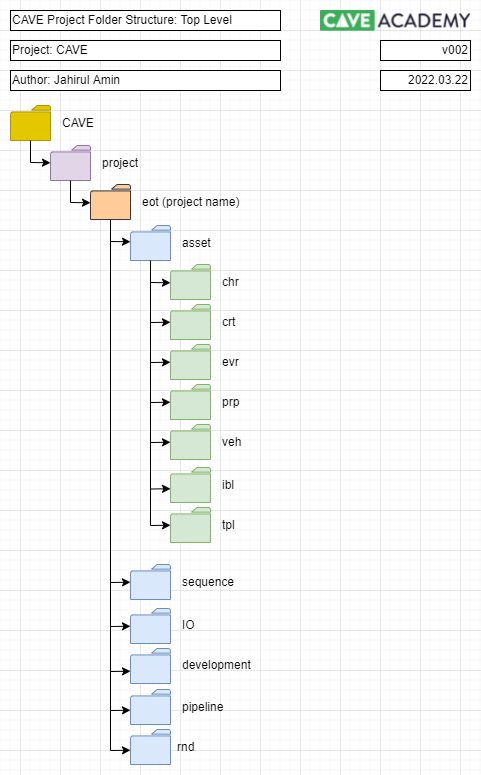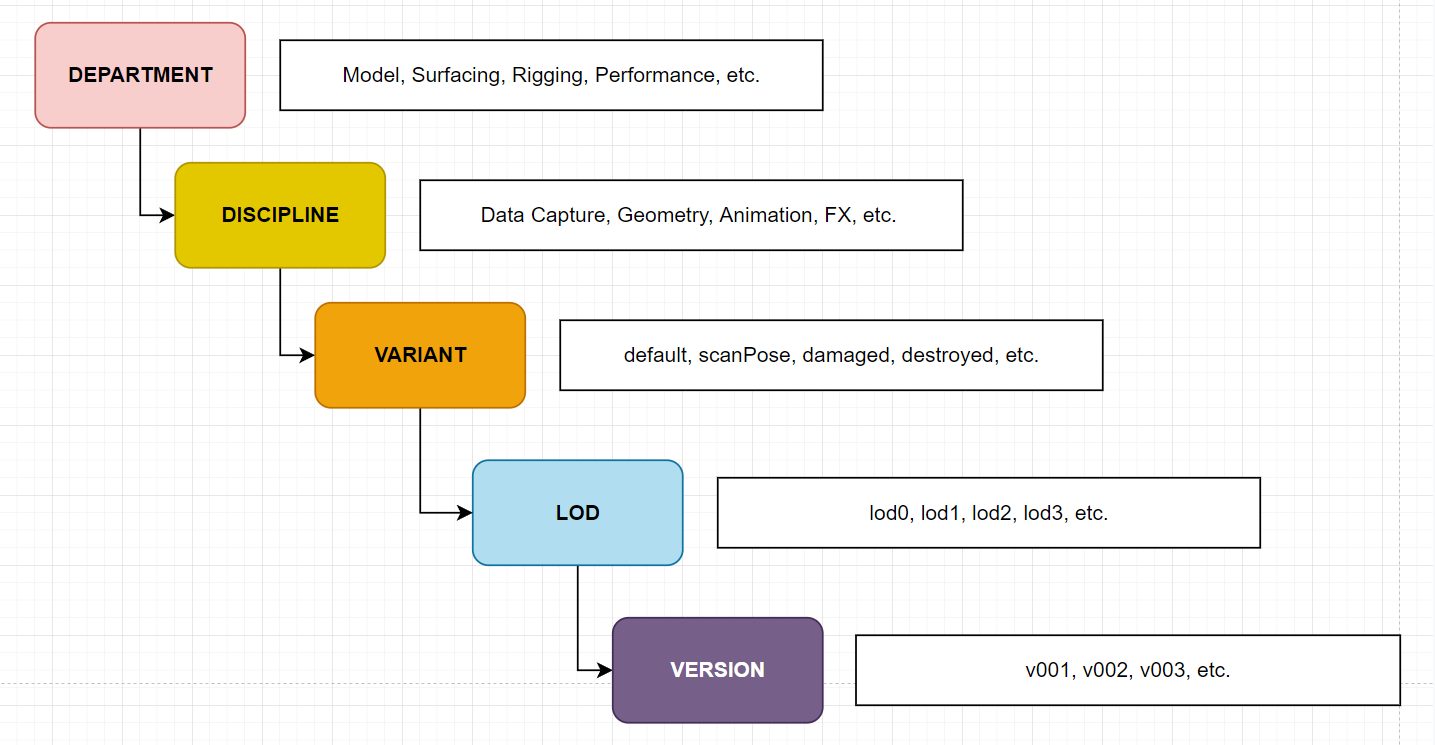Search the wiki
VFX Asset Directory
Assets
The /asset directory is where we will maintain all published, versions and wip files.
The asset directory will start with the following default directories.
- chr: for humans, robot overlords, etc.
- crd: for crowds
- crt: for animals, fantasy creatures, etc.
- evr: for cities, mountains, buildings, etc.
- prp: for weapons, toys, plates, cups and saucers, etc.
- veh: for planes, trains, and automobiles
- ibl: this will be for individual lights and 360 spherical maps
- tpl: this will be for template scenes for turntables and anything similar
For more complex projects, we may add additional asset sub-directories. For example, we may add the following sub-directories to vehicles: boats, cars, planes.
Each asset will have its own directory (for example …/asset/chr/yuki/ or …/asset/evr/japaneseShrine/) and for some assets, we’ll have a consistent set of sub-folders. For example, for characters, we’ll always have the following:
- body – for different variants of body states (damaged, default, etc.)
- face – for FACS shapes
- costume – for different variants of costumes (disco, casual, etc.)
For other assets, you’ll need to think about how best to split things up. For example, for a large environment, you could break things down into regions or individual buildings. A detailed breakdown of the asset requirements will need to take place to determine how best to split up an asset.
And then within each variant, we’ll have the following 3 folders:
- wip: this will contain user work-in-progress files. These files should not be passed down the pipeline.
- versions: All versions submitted for review will be placed within this directory. The files should not be passed down the pipeline.
- published: this will contain all published files which will be passed down the pipeline to other departments. We’ll be looking to copy the latest and approved version file into this folder. The version number should be stripped out of the file name.
wip
For WIP (work-in-progress) asset-based data, we’ve created a number of application folders. It will be down to you to work in the most relevant folder. For some application folders, we’ve created the default application directory (for example Maya and Houdini), and for others, we’ve created a subset of folders (out, projects, resources).
We also have a /user folder, so should you wish to experiment, you can use this as a sandbox. When workign in the /user folder, do create your own username directory, so your sandbox does not clash with others. For example:
- /asset/yuki/wip/user/jamin
The data in the wip directory should never be passed directly down the pipeline. The wip folder is where you create content. And ehen you are happy with your work, you should submit the data by copying it over to the versions directory. And you’ll need to make sure it is pipe-friendly at that stage too.
In regards to naming your wip asset files, please refer to the following doc: Assets WIP File Naming Conventions (coming soon)
version
The asset directory is where we’ll host all the data that we’ll be looking to review. Everything should be version controlled here, so we can revert to a previous version if need be. Files will need to be named appropriately and later on, we’ll be developing a series of tools to allow for the easy submission of data and creation of viewables.
In a nutshell, when submitting your work to the version directory, assume it will be approved and published. Therefore, you’l need to ensure your work is pipe-friendly. Please note the folder structure contains the following hierarchy (other than Shoot and Concept which do not require LODs):
The version directory will consist of the following directories:
- data – the actual scene files that need to be passed through the pipeline. This could be a .ma file, an obj, a set of textures.
- viewables – this is where you will store the accompanying images and videos to support your data.
- feedback – once your work has been reviewed and if feedback is required, this is where you’ll find it.
published
Once a version has been approved, it will be copied into the published directory. Please note, the version id should be stripped out of the name and the info.txt file should be updated to inform others of the version being used.
In regards to naming your published asset files, please refer to the following doc: Assets Published File Naming Conventions (coming soon)
The (very long) diagram below gives a breakdown of all the asset stages and how published data will be managed on-disk. Please note the folder structure contains the following hierarchy (other than Shoot and Concept which do not require LODs):
Support CAVE Academy
Here at CAVE Academy the beauty of giving and sharing is very close to our hearts. With that spirit, we gladly provide Masterclasses, Dailies, the Wiki, and many high-quality assets free of charge. To enable the team to create and release more free content, you can support us here: Support CAVE Academy







